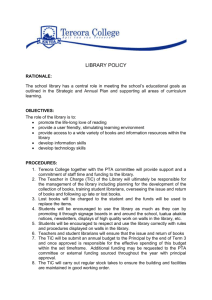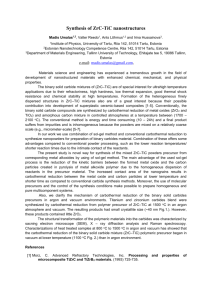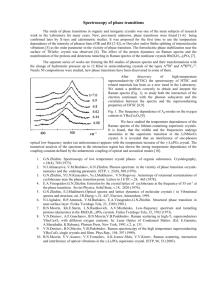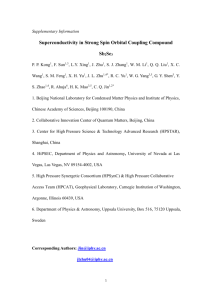References - L`Information scientifique au service de la recherche
advertisement
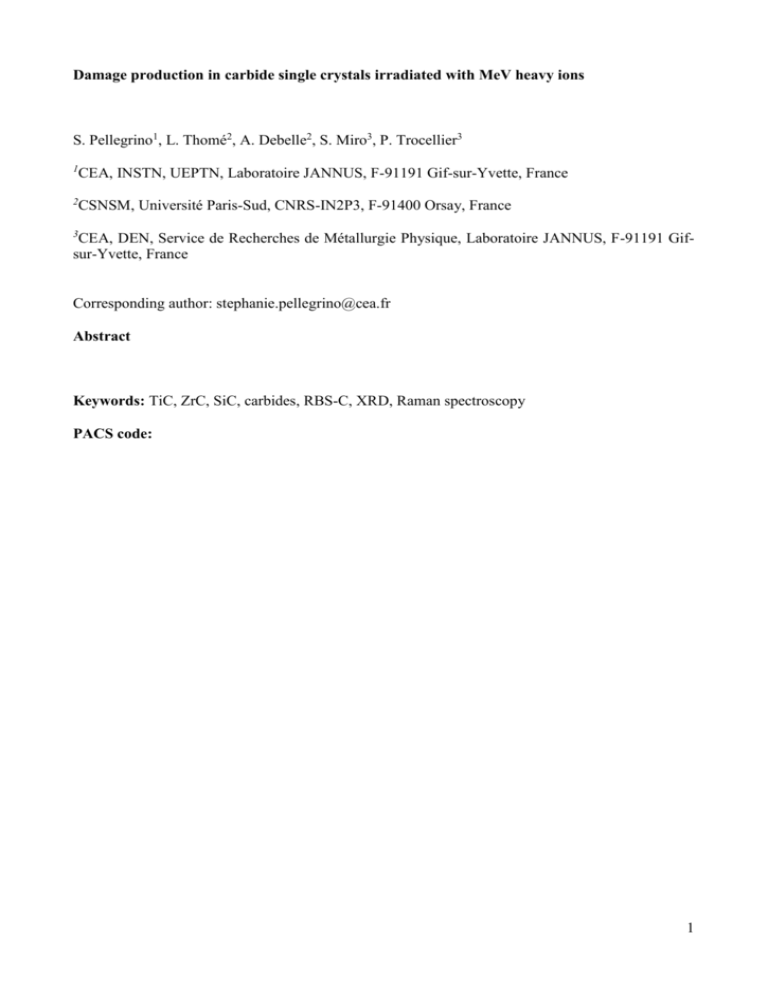
Damage production in carbide single crystals irradiated with MeV heavy ions S. Pellegrino1, L. Thomé2, A. Debelle2, S. Miro3, P. Trocellier3 1 CEA, INSTN, UEPTN, Laboratoire JANNUS, F-91191 Gif-sur-Yvette, France 2 CSNSM, Université Paris-Sud, CNRS-IN2P3, F-91400 Orsay, France 3 CEA, DEN, Service de Recherches de Métallurgie Physique, Laboratoire JANNUS, F-91191 Gifsur-Yvette, France Corresponding author: stephanie.pellegrino@cea.fr Abstract Keywords: TiC, ZrC, SiC, carbides, RBS-C, XRD, Raman spectroscopy PACS code: 1 1. Introduction In order to satisfy thermical, mechanical and resistance requirements imposed in nuclear reactors, carbides like SiC, TiC and ZrC which have exceptional combination properties such as: high electrical and thermal conductivities, chemical behavior, crystal structure, good mechanical and physical properties and corrosion resistance, are the most promising candidates for gas-cooled fast reactor fuel matrix materials. It is well established that irradiation of SiC with neutrons or lowenergy heavy ions leads to the amorphization of this material by nuclear elastic collisions [1-5], that induces deleterious modifications such as swelling or crack formation. However, although numerous studies have been already conducted on ion irradiation of SiC, few of them dealt with other carbides, such as TiC and ZrC polycrystalline [6-8 ]. For ZrC polycrystalline, Gosset et al. [7] have shown a moderated swelling and high internal stresses which both satures at Au fluence around 1014 cm-2 (few dpa). They have performed TEM and they have observed high density of small faulted dislocation loops which lead to the formation of a dense dislocation network at the highest fluences (ZrC behaves like a cubic metal under irradiation). Gutierrez et al. [8] have focused on the behavior of Xe implanted at 800 keV, at high temperature (2075 K) in two different stoichiometry of ZrC (influence of residual zirconia inclusions and free carbon), the results show the importance of this stoichiometry and the excellent gas retention capabilities of this carbide at high temperature. Moreover, the literature is extremely poor in papers related to ion irradiation of TiC and ZrC single crystals, certainly due to the difficulty in elaborating high-quality samples. For example, Sato et al. [9] have studied displacement energy of Ti and C in single crystal of TiC after irradiation with 350 keV C+ ions. Gopal Das et al. [10] are interested in the evolution of composition of TiC under irradiation with transmission electron microscope operated at 100 kV, they have shown that an ordered cubic superstructure appears near TiC0.5 because of the displaced carbon atoms diffusing to the surface and leaving an increasingly substoechiometric composition in the irradiated area. Then with continued irradiation, this ordered TiC0.5 was disrupted by disordering of carbon sublattice (by impinging electron). 2 The experiments reported in this article constitute a part of a work which is devoted to the comparison of the damage induced in TiC, ZrC and SiC (used as a reference) single crystals irradiated with MeV heavy ions in order to explore the nuclear collision regime. The damage was evaluated by combining Rutherford backscattering and channeling spectrometry (RBS-C), X-ray diffraction (XRD) and Raman spectroscopy (the complementarity of these techniques has been demonstrated in several works [11-13]). 2. Experimental procedures The samples used are (0001)-oriented 6H-SiC single crystals supplied by CREE Research Inc, and (100)-oriented TiC and ZrC single crystals (purity 99.99%) supplied by MaTecK GmbH. Prior to ion irradiation, the oxygen contamination was checked by using the 16O(d,p1)O17 nuclear reaction analysis with a deuteron energy Ed = 900 keV, a detection angle of 150° and a 12µm thick mylar screen in front of the detector. The fact that no signal appears at the expected energy of protons Ep~1490 keV assures that the samples contain less than 1015 O atoms×cm-², which is the nuclear reaction analysis threshold. All ion irradiations at low energy have been performed at room temperature (RT) in a random direction with 1.2 MeV Au2+ ions at the JANNUS facility (CSNSM in Orsay and SRMP in Saclay). The range of Au ions obtained from SRIM [14] is ~ 200 nm for SiC, TiC and ZrC. All single crystals were simultaneously irradiated under the same conditions at two ion fluences: 2.8×1014 and 3.3×1015 cm-². To determine the damage profiles, RBS-C experiments were carried out with the ARAMIS accelerator using a 1.4 MeV 4He+ ion beam. The detector is positioned at 165° with respect to the incident beam direction. The energy resolution of the experimental setup is about 12 keV. The depth distribution of accumulated damage (fD) was extracted from the analysis of RBS-C spectra with the McChasy Monte-Carlo simulation code [15]. For the simulations we used the basic assumption that a fraction fD of (Si, Ti, Zr) atoms were randomly displaced from their original 3 lattice site during irradiation. XRD experiments were carried out at the IEF in Orsay (for a complete description of the set-up, see e.g. [16]) in order to mainly determine the irradiation-induced strain level. The wavelength of the X-ray beam was 0.15406 nm (Cu-K1 radiation) and the beam divergence was 18’ arc-second. -2 scans were recorded on the (00012) and on the (400) reflections of the hexagonal SiC and cubic TiC and ZrC crystals, respectively. Raman experiments were carried out on an Invia Reflex Renishaw® spectrometer. The spot size under the ×100 objective was 2 µm2. The laser power was filtered down to 5mW to avoid any transformation of the matter by heating. Spectra were recorded with a resolution of 1.5 cm-1. Samples were studied with an excitation wavelength of 532 nm. A spectral window between 14 and 1800 cm-1 was observed. 3. Results and discussion 3.1. RBS-Channeling Random and aligned RBS-C spectra recorded on SiC, TiC and ZrC crystals are displayed in Figure 1. All random spectra exhibit a plateau starting at 800, 1000 and 1200 keV which corresponds to the backscattering of analyzing particles from Si, Ti and Zr atoms of crystals, respectively. A second plateau, starting at 350 keV, appears on SiC, due to the backscattering of analyzing particles from C atoms. On virgin crystals a strong decrease of the backscattering yield is observed in the main axis direction, due to channeling effect. The spectra recorded in axial orientation on ion-irradiated crystals strongly depend on the compound: the aligned yield already reaches the random level at the lowest fluence (2.8×1014cm-²) in SiC, whereas it is still very low at this fluence in TiC and ZrC. At the highest fluence (3.3×1015cm-²), the disorder expands towards greater depth in SiC and it becomes significant in TiC and ZrC. The insets of Figure 1 show the variation of fD as a function of depth in SiC, TiC and ZrC crystals. As expected from the spectra, fD = 1 at all fluences for SiC, indicating the creation of a 4 complete disorder (amorphization). This amorphous layer broadens with increasing fluence from 2.8×1014 to 3.3×1015cm-². Contrary to SiC, the channeling RBS yield in TiC and ZrC does not reach the random level up to the highest fluence of 3.3×1015cm-² . The value of fD is very low (<0.1) in the whole analyzed depth at 2.8×1015cm-², but it increases markedly around 200 nm (fD ~0.5) at 3.3×1015cm-². This result demonstrates that TiC and ZrC have similar behavior under ion irradiation, and they are much more radiation tolerant than SiC. Both carbides TiC/ZrC exhibit a pronounced tail of the defect distribution figures 1-b and 1-c in agreement with data obtained by Wesch et al. [17] for ZnO and from Wendler et al. for MgO [18]. These authors assume that the implanted layers contain a mixture of point defects and point defects clusters and extended defects most probably dislocation loops [19, 20] which were found to occur at least after implantation at room temperature. It is also demonstrated by Van Brutzel et al. [21] that in ZrC, collision cascade shows three different time steps: a collision phase, a subsequent thermal spike and finally a relaxation phase. At the end of the cascade, the NaCl structure is conserved; very few interstitials of each species are found and very few anti-sites remain. Two different chemical interstitials form small interstitial dislocation loops. Further studies on overlaping of cascades in ZrC are in progress and the same work on TiC should be carried out. According to Phillips [22] and contrary to purely covalent compound as SiC, materials, predominantly ionic insulators such as MgO, retain longrange crystalline order as long as the samples keep their stoichiometry. He concludes that non amorphizability is the result of recombination-enhanced defect annealing. Few works on MgO [18] are interesting too; they prove that this oxide doesn’t reach amorphization. At low ion fluence collision cascade do not overlap and the defects can be characterized as point defects or clusters of points defects randomly distributed. At higher ion fluence, implantation produces a mixture of clusters of points defects, dislocations and dislocation loops. When collision cascades overlap defect annealing and defect rearrangement may occur, it means that mobility of some kind of defects play a relevant role in non amorphization process. According to Zinkle [23], ionizing radiation can inhibit or enhance defect cluster accumulation processes depending on the material, 5 electron-hole per dpa ratio, irradiation flux and magnitude of the electronic stopping power. Further experiments on synergetic effect of electronic energy losses and nuclear energy losses should to be performed. 3.2.X-Ray diffraction -2 scans recorded on SiC, TiC and ZrC are displayed in Figure 2. In this figure, the scattered intensity is plotted as a function of the scattering angle (2) and the elastic strain, N (top axis). For all the curves, the signal detected at high-angle corresponds to the scattering of X-ray beam by the virgin part of the crystals (the thickness probed by X-rays is larger than the irradiated layer). This signal is used to quantify the irradiation-induced elastic strain in the sample. After irradiation a new signal appears, coming from the damaged part of the crystals. This new signal is located at lower 2 angles, revealing an increase of the interplanar distance in the direction normal to the surface of the crystals. In Figure 2-a, which presents data corresponding to SiC, the shape of the XRD curves for irradiated crystals has been shown to be due to the scattering of the X-ray beam by the strained amorphous-crystalline interface at the backside of the irradiated layer [24]. This finding implies that an amorphous layer is formed at the two used fluences in SiC, which is consistent with RBS/C results and in agreement with the data already available in the literature [1,13]. XRD results for TiC and ZrC are represented in Fig. 2-b and 2-c, respectively. Both compounds seem to exhibit a similar behaviour, different from that observed for SiC, as previously noticed by RBS/C. At low fluence, XRD curves displaying characteristic features of irradiated single-crystals at low damage level are observed [12,13]. These patterns indicate a likely presence of a defective but still highly crystalline irradiated layer exhibiting a strain depth profile whose maximum reaches ~0.44% and ~0.38% for TiC and ZrC (Fig.2-c), respectively. At 3.3×1015 at/cm², the shape of the XRD patterns is drastically modified, similarly to what has been observed in other irradiated ceramic materials (see e.g. [12,13]). This change has been ascribed to a significant increase of the disorder level, consistently 6 with channelling results, but no amorphization is suggested. Further experiments, and particularly reciprocal space mapping, are required to confirm this assumption. 3.3.Raman spectroscopy The spectrum of a virgin 6H–SiC sample is displayed in Figure 3-a. Group-theoretical analysis shows that the Raman-active modes of the C6v symmetry for hexagonal polytypes are the A1, E1 and E2 modes. The A1 and E1 phonon modes are splitted into longitudinal (LO) and transverse (TO) optical modes. In backscattering geometry, the A1 (LO) (964 cm-1), E1 (TO) (795 cm-1) and E2 (766 and 789 cm-1) phonon peaks are the main lines detected in the Raman spectra. The high quality of the crystal allows the observation of several weaker peaks along with the second order Raman peaks located at the 260-520 and 1500–1700 cm-1 wave number ranges, respectively. Irradiation of 6H–SiC induces an extinction of the Raman lines related to crystalline lattice phonons (where fDMax = 1 in RBS-C) and the appearance of several new Si–C (768 and 924 cm-1), Si–Si (525 cm-1) and C–C (1400 cm-1) related bands [25, 26]. The new Si–C bands are attributed to the breakdown of the Raman selection rules induced by the damage formation. Si–Si and C–C vibrations indicate the formation of homonuclear bonds within the amorphous SiC network. Increasing the fluence induces a decrease in the crystal peak intensities and an enhancement of the homonuclear band intensities. The phonon peaks completely vanish at 3.3×1015 cm-2. Only four broad lines remain in the Raman spectrum at around 200, 500, 800 and 1400 cm-1, which are equally distributed over the three domains of vibrations: Si–Si, Si–C, Si–C and C–C. The virgin and irradiated spectra of TiC are presented in Figure 3-b. Stoichiometric TiC has the NaCl structure with every atom at a site of inversion symmetry and has no vibrational modes. The carbon vacancies destroy the inversion symmetry at the sites of nearby atoms, thereby making their displacements Raman active. All the Raman peaks obtained in TiCx, where x<1, are disorderinduced Raman peaks due to carbon vacancies. The Raman spectra of TiCx for (0.86<x<0.97) have been reported by Klein et al. [27]. With decreasing x, the Raman peaks broaden, in relation with vacancy clustering. By comparison with Klein et al’s data the virgin spectrum obtained in this study 7 seems very similar to that from TiC0.9 in A1g + 4/3 Eg configuration. In Klein’s work, the four predominant peaks appear at 288, 382, 565 and 660 cm-1. A shoulder located at 424 cm-1 is observed, also in the A1g spectrum of TiC0.97 in full agreement with our results. In our study, the four main peaks grow at 288, 386, 580 and 670 cm-1 which are in good agreement with values obtained by Klein et al. We can observe also a shoulder at 420 cm-1. The peaks increase with fluence but no amorphization is observed. ZrC does not give the first-order Raman scattering because of its NaCl structure like TiC. However Wipf et al. [28] observed defect-induced Raman bands in ZrC1-x positions due to the optical branch (O2) of phonon spectra at around 600 and O1 at around 530 cm-1 (for ZrC0.87). The virgin and irradiated spectra of ZrC are presented in Figure 3-c. The peaks observed in this study at about 600 and 515 cm-1 are ascribed to these. Then the peaks located at 204 and 275 cm-1 are attributed to the acoustic branches corresponding to A1 at 207 and A2 at 270 cm -1 by Wipf et al. These peaks increase and broaden with fluence and like TiC no amorphization is observed. For both carbides TiC and ZrC, we clearly see the separation between the lower frequency acoustic branches and the higher frequency optical branches of the phonon spectra. This separation is well known from the neutron scattering data and is caused by the large mass difference between carbon and transition metal atoms such as Zr and Ti [29-31]. Each of the main one-phonon Raman peaks in figure 3-b and 3-c splits into a doublet due to different contributions to the density of states from longitudinal and transverse branches. We can note that for each doublet the ratio between the lowest frequency peak over the highest one increases with fluence. As noted by Wipf et al. [28], the morphology of the sample surface has a significant influence on the Raman spectra especially the polishing (electropolished or mechanically polished). Actually, subsurface mechanical damage can markedly affect the Raman spectra. Peaks located at around 1400 and 1600 cm-1 appear on irradiated samples and correspond to C-C bands. These ones increase with fluence too and are negligible on virgin spectra for both carbides. 8 4. Conclusion SiC has a tetrahedral structure and covalent bonds are predominant, TiC/ZrC have NaCl structure with carbons located on octahedral sites, with a mixture of covalent and ionic bonds. The first results showed in this study prove a clearly different behaviour between SiC and TiC/ZrC. In SiC, it is established that Au ions irradiation induces collision cascades with small interstitials and anti-sites defects distributed over a wide region. The local accumulation of these defects up to a certain threshold energy deposited per lattice atom transforms the SiC crystal into amorphous. Contrary to SiC, the channeling RBS yield in TiC/ZrC does not reach random level and the maximum defect concentration amounts 0.5 only. As demonstrated by MD simulation [20] in ZrC, irradiation induces interstitials and few anti-sites of each species then clusters of interstitials tend to form small interstitial dislocation loops at the end of the cascade (extended defects), but no amorphization is observed. XRD and Raman results confirm those obtained by RBS-C namely crystallinity is conserved for TiC/ZrC even at high fluence 3.3×1015 cm-2 when SiC is already amorphous from the lower fluence 2.8×1014 cm-2. The more ionic character of TiC/ZrC compared with SiC could play an important role in the defect dynamics allowing the existence of mobile point defects at RT that could migrate rapidly under ion irradiation. Further TEM observations should be performed to confirm MD simulations on the nature of the defects created under irradiation in order to explain the difference between SiC and carbides like TiC/ZrC. Other fluences have to be investigated to obtain a complete damage build-up of TiC/ZrC. Naguib and Kelly [32] showed that ionic insulators retains long-range crystalline order as long as the samples retain their stoichiometry. This remark encourages us to carry out stoichiometry measurements of TiC/ZrC before and after irradiation too. 9 References [1] W. J. Weber, N. Yu, L. M. Wang, J. Nuc. Mat.253 (1998) 53-59. [2] W. Jiang, W. J. Weber, J. Lian and N. M. Kalkhoran, J. Appl. Phys. 105, 013529 (2009). [3] E. Wendler, A. Heft, W. Wesch, NIM B 141 (1998) 105-117. [4] A. Debelle, L. Thomé, D. Dompoint, A. Boulle, F. Garrido, J. Jagielski, D. Chaussende, J. Phys. D: Appl. Phys. 43 (2010) 455408. [5] A. Benyagoub, NIM B 266 (2008) 2766-2771. [6] D. Simeone, D. Gosset, DEN Internal Report “Contribution à l’étude du comportement hors et sous irradiation des composes ZrC et TiC” 2004. [7] D. Gosset, M. Dollé, D. Simeone, G. Baldinozzi, L. Thomé, J. Nucl. Mat. 373 (2008) 123-129. [8] PhD thesis of G. Gutierrez, university of Lyon, “Etude du comportement thermique et sous irradiation du xenon dans l’oxycarbure de zirconium”, 2011. [9] K. Sato, Y. Fujino, S. Yamaguchi, H. Naramoto, K. Ozawa, NIM B 47 (1990) 421-426. [10] Gopal Das, Dilip K. Chatterjee, Harry A. Lipsitt, J. Mat. Science 16 (1981) 3283-3291. [11] A. Bellucci, D. Gozzi, T. Kimura, T. Noda, S. Otani, Surf. And Coatings Tech. 197 (2005) 294-302. [12] S. Moll, L. Thomé, G. Sattonnay, A. Debelle, L. Vincent, F. Garrido, J. Jagielski, J. Appl. Phys. 106 (2009) 073509. [13] A. Debelle, A. Declémy, L. Vincent, F. Garrido, L. Thomé, J. Nucl. Mater. 396 (2009) 240. [14] J. F. Ziegler, http://www.srim.org/ [15] J. Jagielski, L. Thomé, Radiat. Eff. Def. In Solids 166 N°5 (2011) 367-372. [16] IEF voir avec Aurélien Debelle [17] W. Wesch, E. Wendler, C. S. Schnohr, NIM B277 (2012) 58-69. [18] E. Wendler, K. Gärtner, W. Wesch, NIM B 266 (2008) 2872-2876. [19] E. Wendler, O. Bilani, K. Gärtner, W. Wesch, M. Hayes, F. D. Auret, K. Lorenz, E. Alves, NIM B 267 (2009) 2708-2711. [20] G. Perillat-Merceroz, P. Gergand, P. Marotel, S. Brochen, P.-H. Jouneau, G. Feuillet, J. Appl. Phys. 109 (2011) 023513. [21] L. Van Brutzel, J. P. Crocombette, NIM B 255 (2007) 141-145. 10 [22] J. C. Phillips, Phys. Rev. B 29 (1984) 5683. [23] S. J. Zinkle, V. A. Skuratov, D. T. Hoelzer, NIM B 191 (2002) 758-766. [24] PhD thesis of C. Dupeyrat, University of Poitiers, “Etude de l’implantation d’atomes de fer dans le carbure de silicium 6H- en vue de l’élaboration d’un nouveau semi-conducteur magnétique dilué”, 2009. [25] S. Miro, J.-M. Costantini, S. Sorieul, L. Gosmain, L. Thomé, Philos. Mag. Lett. (2012) 1-7, iFirst. [26] S. Sorieul, DEN Internal Report “effets d’irradiation dans le carbure de silicium. Rapport bibliographique » 2004. [27] M. V. Klein, J. A. Holy and W. S. Williams, Phys. Rev. B 17, number 4 (1978) 1546-1556. [28] H. Wipf, M. V. Klein and W. S. Williams, Phys. Stat. Sol. B 108 (1981) 489-500. [29] H. G. Smith, W. Gläser, Phys. Rev. Letters 25 (1970) 1611. [30] H. G. Smith, W. Gläser, Phonons, Ed M. A. Nusimovici, Flammarion Sciences, Paris 1971, p 145. [31] H. G. Smith, Phys. Rev. Letters 29 (1972) 353. [32] H. M. Naguib, R. Kelly, Radiat. Eff. 25 (1975) 1. 11 Figure captions Figure 1: RBS-C spectra recorded in random (filled circles) and axial (open symbols) directions on SiC, TiC and ZrC crystals simultaneously irradiated with 1.2 MeV Au2+ ions at 2.8×1014 and 3.3×1015 cm-2. The energy of the analyzing beam is 1.4 MeV. The insets show the variation of fD as a function of depth extracted from the analysis of RBS-C spectra with the McChasy code (lines superimposed to the spectra). Figure 2: -2 scans recorded in the vicinity of the (00012) and (400) reflections of hexagonal SiC and cubic TiC/ZrC, respectively. The X-ray wavelength is 0.15406 nm. The upper axis indicates the elastic strain in the direction normal to the surface. Curves are shifted vertically for visualization easiness. Figure 3: Raman spectra on 6H–SiC, TiC and ZrC single crystals before and after irradiation with 1.2 MeV Au ions at 2.8×1014 and 3.3×1015 cm-2. 12 (a) SiC 1.0 fD 40 0.5 30 0.0 YIELD 0 200 400 DEPTH (nm) 600 20 10 0 300 virgin 14 2.8x10 15 3.3x10 400 500 600 ENERGY (keV) 700 800 80 1.0 fD (b) TiC 0.5 60 0.0 YIELD 0 200 400 DEPTH (nm) 600 40 20 0 500 virgin 14 2.8x10 15 3.3x10 600 700 800 ENERGY (keV) 900 1000 200 1.0 fD (c) ZrC 0.5 150 0.0 YIELD 0 200 400 DEPTH (nm) 600 100 50 0 600 virgin 14 2.8x10 15 3.3x10 700 800 900 1000 1100 1200 ENERGY (keV) Figure 1 13 (a) (b) (c) Figure 2 14 -1 -1 A1-LO-964 cm -1 E2-TO-789 cm E2-TO-766 cm Scale factor Virgin 14 -2 2.8 x 10 cm 15 -2 3.3 x 10 cm 1700 cm-1 1500 cm-1 E1-TO-795 cm 520 cm-1 250 cm-1 Intensity (arb. u.) -1 (a) SiC x2 C-C Si-Cdisordered Si-Cdisordered Si-Si x2 200 400 600 800 1000 1200 1400 1600 1800 -1 -1 -1 O2-670 cm O1-580 cm virgin 14 -2 2.8 x10 cm 15 -2 3.3 x10 cm -1 (b) TiC 200 1600 cm 1400 cm -1 420 cm Intensity (arb.u.) -1 A2-386 cm -1 A1-288 cm -1 Wavenumber (cm ) 400 600 800 1000 1200 1400 1600 1800 -1 -1 -1 O2-600 cm O1-515 cm virgin 14 -2 2.8x10 cm 15 -2 3.3x10 cm (c) ZrC 1600 cm A1-204 cm -1 1400 cm -1 -1 Intensity (arb. u.) A2-275 cm -1 Wavenumber (cm ) 200 400 600 800 1000 1200 1400 1600 1800 -1 Wavenumber (cm ) Figure 3 15
